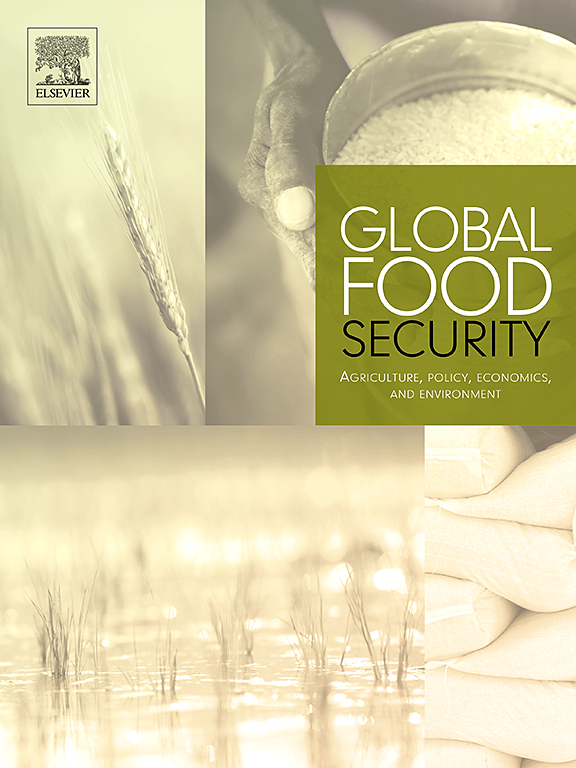Multisectoral behavior change intervention improves diet quality, but not food security, in rural Uganda
IF 9.6
1区 经济学
Q1 FOOD SCIENCE & TECHNOLOGY
Global Food Security-Agriculture Policy Economics and Environment
Pub Date : 2024-12-01
DOI:10.1016/j.gfs.2024.100817
引用次数: 0
Abstract
Multi-sectoral interventions targeting nutrition have shown promise in low- and middle-income settings. A 1:1:1 multi-level cluster-randomized controlled trial assessed the impact of two 12-week social behavior change interventions called Nutrition Impact and Positive Practice (NIPP) and NIPP+. The NIPP intervention sought to improve participants’ food security, diet quality, and water, sanitation, and hygiene. The NIPP + intervention used additional nudges to improve agricultural practices. Nearly 900 households from 60 clusters in the Agago District of Uganda were randomized to one of three arms: Control, NIPP, and NIPP+. Impacts on maize yield, household food security, diet quality, and child anthropometry were assessed using generalized linear mixed models. Post-intervention, NIPP + children had 2 times increased odds of achieving a minimum acceptable diet (MAD) (OR = 2.04; 95% CI = 1.04, 3.99; p = 0.039) compared to control. One year post intervention, women in NIPP (OR = 2.27; 95% CI = 1.38, 3.74; p = 0.001) and NIPP+ (OR = 2.81; 95% CI = 1.71, 4.61; p < 0.000) had more than two times increased odds of achieving minimum dietary diversity (MDDW) compared to control, and children in NIPP + had a mean mid-upper arm circumference that was 0.217 cm higher (β = 0.217; 95% CI = 0.033, 0.402; p = 0.022) compared to control. We detected no significant effects on maize yield, household food security, or child dietary diversity. This study demonstrates the potential for the NIPP and NIPP + interventions to improve diet diversity, independent of improvements to either agricultural production or household food security.
多部门行为改变干预措施改善了乌干达农村的饮食质量,但不能改善粮食安全
针对营养的多部门干预措施在低收入和中等收入环境中显示出了希望。一项1:1:1的多层次集群随机对照试验评估了两项为期12周的社会行为改变干预措施的影响,即营养影响和积极实践(NIPP)和NIPP+。NIPP干预旨在改善参与者的食品安全、饮食质量、水、环境卫生和个人卫生。NIPP +干预措施使用了额外的推动措施来改善农业实践。来自乌干达Agago地区60个组群的近900户家庭被随机分为三个组:对照、NIPP和NIPP+。使用广义线性混合模型评估了对玉米产量、家庭粮食安全、饮食质量和儿童人体测量的影响。干预后,NIPP +儿童达到最低可接受饮食(MAD)的几率增加了2倍(OR = 2.04;95% ci = 1.04, 3.99;P = 0.039)。干预后1年,NIPP妇女(OR = 2.27;95% ci = 1.38, 3.74;p = 0.001)和NIPP+ (OR = 2.81;95% ci = 1.71, 4.61;p & lt;0.000)与对照组相比,达到最低膳食多样性(MDDW)的几率增加了两倍以上,NIPP +儿童的平均上臂中围高0.217厘米(β = 0.217;95% ci = 0.033, 0.402;P = 0.022)。我们没有发现对玉米产量、家庭粮食安全或儿童饮食多样性有显著影响。这项研究证明了NIPP和NIPP +干预措施在改善饮食多样性方面的潜力,而不依赖于农业生产或家庭粮食安全的改善。
本文章由计算机程序翻译,如有差异,请以英文原文为准。
求助全文
约1分钟内获得全文
求助全文
来源期刊

Global Food Security-Agriculture Policy Economics and Environment
FOOD SCIENCE & TECHNOLOGY-
CiteScore
20.90
自引率
3.40%
发文量
69
期刊介绍:
Global Food Security plays a vital role in addressing food security challenges from local to global levels. To secure food systems, it emphasizes multifaceted actions considering technological, biophysical, institutional, economic, social, and political factors. The goal is to foster food systems that meet nutritional needs, preserve the environment, support livelihoods, tackle climate change, and diminish inequalities. This journal serves as a platform for researchers, policymakers, and practitioners to access and engage with recent, diverse research and perspectives on achieving sustainable food security globally. It aspires to be an internationally recognized resource presenting cutting-edge insights in an accessible manner to a broad audience.
 求助内容:
求助内容: 应助结果提醒方式:
应助结果提醒方式:


